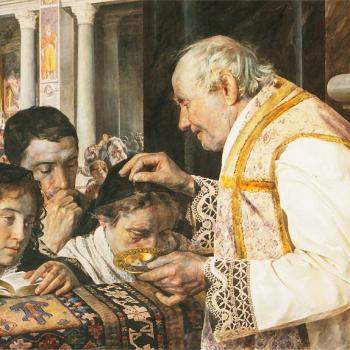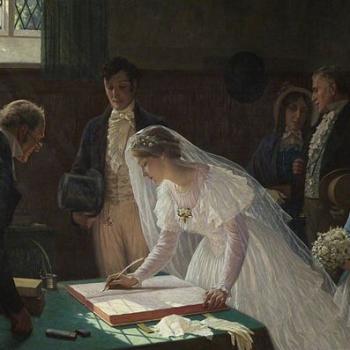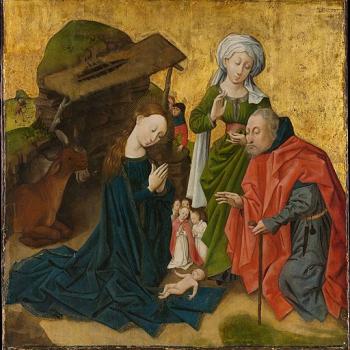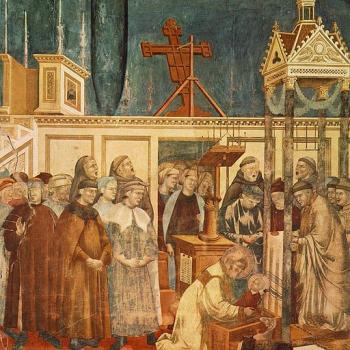This post goes out to our long time follower and commentator Agellius, as it was sparked in part by a disagreement we have had over the years about the role and impact of the changes wrought by Vatican II. Agellius, I am sure you will not agree with what I wrote, but I hope you find the passage quoted below worth thinking about.
At some point I picked up a copy of Fr. Raymond E. Brown’s book, The Churches the Apostles Left Behind. Published in 1984, it is an expanded and revised version of the Sprunt Lectures he delivered at Union Theological Seminary in 1980. (This is the “other” Union, in Richmond, VA). It is a historical-critical analysis of the church in the last 1/3 of the first century; his goal is to explore how the church preserved its identity in the period after the death of the apostles. He combines his scriptural analysis with pastoral reflections, discussing the strengths and weaknesses of the solutions that he believes various communities adopted.
One of these he refers to as the Community of the Beloved Disciple: the church that formed around the writer of the Gospel of John and was later addressed by the author of the Johannine epistles (whom he argues were different people). In his analysis he finds a community that has been split twice. First, it was thrown out of the synagogues resulting in an alienation from its Jewish heritage that is seen in the Gospel of John. (Jewish law, feasts, etc. are the domain of “the Jews” and not of the nascent Christian community.) Second, the community was split by doctrinal controversy, with the author of the Johannine epistles attacking “secessionists” (Brown’s terminology) who have pushed the theological ideas of their foundation document (John’s gospel) too far.
In his pastoral reflections on this history and its import for the Church today, Brown first discusses the Reformation, but then turns his attention to Vatican II, which at the time of his talks was less than 20 years in the past. I want to quote his argument in detail:
I have insisted in this book that for every theological insight one pays a price. The more brilliant the insight, the more likely that other aspects of truth will be put into the shade, often to be overlooked and forgotten. A balanced religious group, sufficiently confident of its great insights, is not afraid peacefully to look back in order to reclaim what was lost by the very fact that it urged those insights so strongly. But where polemic has been the midwife in bringing to birth a community’s identifying insights, the possibility of reaching back to regain some of the lost heritage is significantly diminished. In such a situation self-identity has been fortified by propaganda against the lost values as if they were worthless…..
A[n]…example of the loss of heritage has been brought home to Roman Catholics by Vatican II. There was little public polemic in the Council, as changes were made in basic attitudes toward liturgy, law, and lifestyle. But Roman Catholicism suffered from the suddenness and dramatic quality of the changes, so that polemics followed the Council; and a Catholicism marked by the dramatic shift of Vatican II was passed on to the next generation. The new developments that had affected the lives of the teachers were the substance of the message communicated to the children, but concomitantly this involved a neglect of much Catholic tradition that was not affected by the Council–the distinctive presuppositions of Catholic life. As a result the generation that grew up in the 1970s, while being very aware of some new outlooks of Vatican II, were often painfully ignorant of much of their Catholic heritage. Those who taught the new were at times deaf to cries about the loss of the old, equating all such cries with a traditionalist rejection of the Council. There were and are extremist Catholics opposed to Vatican II, either openly (like Archbishop Lefebvre) or covertly (by constantly citing pre-conciliar documents that point in a direction opposite to Vatican II). But others, and I would include myself among them, while enthusiastic for what was introduced into Catholicism by Vatican II, see no need for the concomitant losses, e.g., of inner-Catholic loyalty, obedience, and commitment to the Church; of dignity in liturgy; of Gregorian chant; of a knowledge of the Latin tradition reaching from Augustine through Thomas to the Middle Ages. To try now to recoup some of those losses while still advancing the gains of Vatican II would be an act of eminent good sense. Let us hope that the bitterness of the exchanges between extremists does not prevent that. (pp. 117-18, emphasis in original)
There is a lot going on here, and I am not really ready to unpack all of it. (I am working on a much more nuanced post on Vatican II, using ideas from continental philosophy about an “Event”, but that is a work in progress that may or may not come to fruition.) I find his point of view interesting and worth considering, though not completely compelling. (Herein lies my past discussions and disagreements with Agellius, alluded to above.) I would note that there is a significant gap in our ages, and I think this is what separates us. Raymond Brown was in his early 30s during Vatican II (he was born in 1928) and in his early 50s when he wrote this passage. By contrast, I was born in 1963, and all of my conscious memory is of the post Vatican II church. So in I am among the group whom he describes thus:
As a result the generation that grew up in the 1970s, while being very aware of some new outlooks of Vatican II, were often painfully ignorant of much of their Catholic heritage.
By chance, I spent the decade after this book was published (though I was not aware of it) filling in many of the gaps in my Catholic heritage. This was a consequence of both the nature of religious education in this period but also the abortive nature of it. (For some of the reasons it was cut short, see my earlier post.) Doing so did give a greater appreciation of the complex history of Catholicism. But, while I find myself sympathetic with some of Fr. Brown’s regrets, I still do not fully share them. I discovered Gregorian chant in the early 80s, and spent a bit of money on expensive Deutsche Gramophone recordings of it. And I was very much taken in by the revival of chant I heard when I visited Taize in 1984. But truthfully, I can take it or leave it as part of our weekly masses. My parish has recently formed a Schola, and musically they are actually pretty good (according to my wife, who herself has sung in choirs for many years). However, it ends up, in my mind, becoming a performance piece that we listen to attentively, but do not engage in actively, which I feel is one of the important changes brought about Vatican II—the full and active participation of the laity in the liturgy. (I had a similar experience when I attended mass at St. Vincent Ferrer in NY last spring while at a conference.)
My feelings about the medieval Latin tradition are equally complicated. During the 1980s I was very happy to discover the rich intellectual tradition of the Church–something that was definitely missing from my religious education. But while I enjoy Aquinas and wish I had the time to read the Summa in depth, I am really not convinced that he is the pinnacle of either Catholic theology or philosophy. And I am very, very glad that anemic scholasticism that was the Baltimore Catechism no longer defines religious education in America. (We have discussed the Baltimore Catechism in the past; see my opinions in the comments here.)
Rather than continuing in this vein, I guess I can say that, in some small way, I have attempted, without putting it into these words, to “recoup some of those losses while still advancing the gains of Vatican II“. I just never felt these were losses that had to be salvaged lest they be forgotten. They were always there, but there were very good reasons why they had gotten put on the shelf in the years after Vatican II. The householder brings out things both old and new (cf. MT 13:52), but sometimes he wants to share what is new.
But again, perhaps this difference of perspective is a function of the different times we live(d) in. The 1970s and early 1980s were a heady time, when the “Spirit of Vatican II” was still effervescent. I write in a much later time, after the long pontificate of St. Pope John Paul II. Through these years I saw a lot of people attempt to “recoup” what they perceive to have been lost, but ignoring the gains made by Vatican II. Recently, this has been driven home to me by the number of very conservative Catholic students at the University of Alabama. At a weekend mass I a liable to see more veils on women than I have seen anywhere outside of an extraordinary form mass. My son introduced me to one of these students, a young woman who seemed driven by an ahistorical nostalgia for a Church she never experienced, but which, moreover, probably never really existed. For her, Vatican II was about what was wrong with the Church, and she simply could not see why people were so excited by it. She was a baffling contradiction to me: a bright young woman who is now seeking a professional career but who agreed with Chesterton that women should not be allowed to vote.
In fairness to her, college is a time of extremes, and perhaps as she moves forward her views will get more nuanced. I know mine did. Pray the both of us do not fall prey to the “bitterness of the exchanges between extremists” that Fr. Brown warned against.
Updated: 4/29/18: at the suggestion of the first comment, I have modified the post to make clear that I am referring to Fr. Raymond E. Brown.












